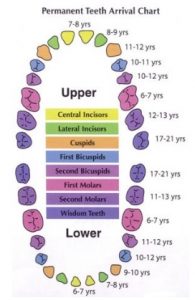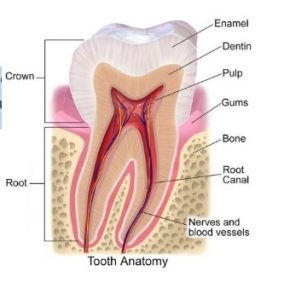
In this blog we’re going to be talking about our permanent teeth and what your dentist is seeing when they look through your mouth.

When do permanent teeth start erupting?
Between the ages of 6 and 12 years old, children should have a full set of permanent teeth in their mouths. Teeth tend to erupt similarly on both sides of the mouth (so when the front tooth on one side goes, the front tooth on the other side goes at a similar time).
How many teeth do we have and what are their functions?
In an adult mouth, there are 32 teeth. This consists of 12 molar teeth, 8 pre-molar teeth, 4 canines, and 8 incisor teeth. They each have their own purpose when we are chewing food.
Molars – Each adult has 4 visible molars at the rear of their mouth on the top and bottom jaw. While most people have their wisdom teeth (which are the third molars that complete the 12), they don’t always penetrate the mouth and often require removal. The molar teeth are used for the crushing and grinding of food.
Pre-molars – The next 2 sets of teeth are called the premolars. They are used for breaking down the food.
Canines – Your canines can be easily spotted as they form a point at the top. The purpose of these teeth is to aid in the tearing and holding of food.
Incisors – The incisor teeth are the front four teeth on the top and bottom of your jaw. These are the first teeth that erupt when you lose your baby teeth. The role of the incisor is the biting and holding of food.
So, what is a tooth made of?
 Teeth are broken down into 2 main sections. These sections are then broken down further as you get deeper into the tooth. You can see the different parts of the tooth in the picture.
Teeth are broken down into 2 main sections. These sections are then broken down further as you get deeper into the tooth. You can see the different parts of the tooth in the picture.
The 2 main sections are:
Crown – The crown is the visible part of the tooth that you see in the mouth. The crown is made up of enamel, dentine, and the tooth’s nerve (pulp).
Root – This is the section of the tooth that is below the gumline. Dentine and the nerve are seen in both the crown and the root portion of the tooth. The roots connect the tooth to the bone and blood vessels of the jaw.
Your dentist is looking at all these parts to ensure the health of your teeth. While cavities are more obviously seen in the mouth as they appear when the enamel breaks down, nerve issues like when a root canal is needed are only visible through x-rays and other testing.
Now you know more about the teeth you have in your mouth. If you have any questions regarding your teeth, don’t forget to ask your dentist at your next check-up!
